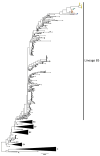Ongoing Evolution of Middle East Respiratory Syndrome Coronavirus, Saudi Arabia, 2023-2024
- PMID: 39641462
- PMCID: PMC11682817
- DOI: 10.3201/eid3101.241030
Ongoing Evolution of Middle East Respiratory Syndrome Coronavirus, Saudi Arabia, 2023-2024
Abstract
Middle East respiratory syndrome coronavirus (MERS-CoV) circulates in dromedary camels in the Arabian Peninsula and occasionally causes spillover infections in humans. MERS-CoV diversity is poorly understood because of the lack of sampling during the COVID-19 pandemic. We collected 558 swab samples from dromedary camels in Saudi Arabia during November 2023-January 2024. We found 39% were positive for MERS-CoV RNA by reverse transcription PCR. We sequenced 42 MERS-CoVs and 7 human 229E-related coronaviruses from camel swab samples by using high-throughput sequencing. Sequences from both viruses formed monophyletic clades apical to recently available genomes. MERS-CoV sequences were most similar to B5 lineage sequences and harbored unique genetic features, including novel amino acid polymorphisms in the spike protein. Further characterization will be required to understand their effects. MERS-CoV spillover into humans poses considerable public health concerns. Our findings indicate surveillance and phenotypic studies are needed to identify and monitor MERS-CoV pandemic potential.
Keywords: MERS-CoV; Middle East respiratory syndrome coronavirus; Saudi Arabia; coronavirus; coronavirus disease; emerging viruses; respiratory infections; virology; viruses; zoonoses.
Figures




References
MeSH terms
Substances
Grants and funding
LinkOut - more resources
Full Text Sources

